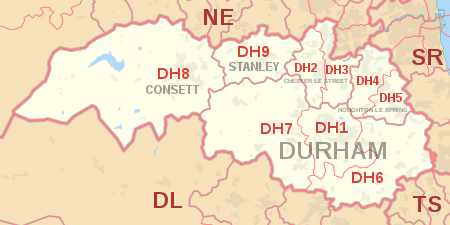The UB postcode area, also known as the Southall postcode area, is a group of eleven postcode districts in England, within six post towns. These cover parts of western and north-western Greater London, plus a very small part of Buckinghamshire. The letters in the postcodes are the phonemic abbreviation of Uxbridge.
The DN postcode area, also known as the Doncaster postcode area, is a group of 32 postcode districts in eastern England, within 13 post towns. These cover eastern South Yorkshire, north Lincolnshire, parts of north Nottinghamshire and the south-west of the East Riding of Yorkshire, and a small part of southern North Yorkshire.
The HP postcode area, also known as the Hemel Hempstead postcode area, is a group of twenty-four postcode districts in England, within eleven post towns. These cover north-west Hertfordshire and central Buckinghamshire.
The SG postcode area, also known as the Stevenage postcode area, is a group of nineteen postcode districts in England, within fifteen post towns. These cover north Hertfordshire and east Bedfordshire, plus a small part of south-west Cambridgeshire and a very small part of Essex.
The SS postcode area, also known as the Southend-on-Sea postcode area, is a group of seventeen postcode districts in England, within eleven post towns. These cover south-east Essex, including Southend-on-Sea, Basildon, Benfleet, Canvey Island, Hockley, Leigh-on-Sea, Rayleigh, Rochford, Stanford-le-Hope, Westcliff-on-Sea and Wickford.
The BA postcode area, also known as the Bath postcode area, is a group of nineteen postcode districts in South West England, within sixteen post towns. These cover east Somerset and west Wiltshire, plus very small parts of north-west Dorset and south Gloucestershire.
The OL postcode area, also known as the Oldham postcode area, is a group of sixteen postcode districts in north-west England, within seven post towns. These cover eastern Greater Manchester, plus small parts of east Lancashire and western West Yorkshire.
The NR postcode area, also known as the Norwich postcode area, is a group of 35 postcode districts in the east of England, within 16 post towns. These cover central and eastern Norfolk and part of north-east Suffolk.
The DL postcode area, also known as the Darlington postcode area, is a group of seventeen postcode districts in England, which are subdivisions of fourteen post towns. These districts cover central County Durham, northern North Yorkshire and a very small part of Cumbria.
The NE postcode area, also known as the Newcastle upon Tyne postcode area, is a group of 61 postcode districts in north-east England covering 34 post towns. These cover most of Tyne and Wear and Northumberland, plus a very small part of northern County Durham. The NE postcode area is one of six with a population above 1 million.
The SR postcode area, also known as the Sunderland postcode area, is a group of eight postcode districts in north-east England, within three post towns. These cover eastern Tyne and Wear and north-east County Durham.
The TS postcode area, also known as the Cleveland postcode area, is a group of 29 postcode districts in northern England for ten post towns. These cover north-east North Yorkshire and south-east County Durham.
The WF postcode area, also known as the Wakefield postcode area, is a group of 17 postcode districts in north-east England, which are subdivisions of eleven post towns. These cover much of southern and eastern West Yorkshire, plus small parts of South and North Yorkshire.
The LA postcode area, also known as the Lancaster postcode area, is a group of 23 postcode districts in north-west England, within 17 post towns. These cover north Lancashire and southern Cumbria, and a small part of North Yorkshire.
The TQ postcode area, also known as the Torquay postcode area, is a group of fourteen postcode districts in South West England, within eleven post towns. These cover much of south Devon, including Torquay, Paignton, Newton Abbot, Brixham, Ashburton, Buckfastleigh, Dartmouth, Kingsbridge, Salcombe, South Brent, Teignmouth and Totnes.
The SN postcode area, also known as the Swindon postcode area, is a group of eighteen postcode districts in England, within ten post towns. These cover north Wiltshire, plus a small part of south-west Oxfordshire and a very small part of Gloucestershire.
The WR postcode area, also known as the Worcester postcode area, is a group of fifteen postcode districts in England, within seven post towns. These cover central and southern Worcestershire, plus very small parts of Herefordshire, Shropshire, Warwickshire and Gloucestershire.
The WV postcode area, also known as the Wolverhampton postcode area, is a group of sixteen postcode districts in England, within four post towns. These cover Wolverhampton, Willenhall and Bilston in the West Midlands, plus parts of south-west Staffordshire and south-east Shropshire.
The CT postcode area, also known as the Canterbury postcode area, is a group of 21 postcode districts in South East England, within 13 post towns. These cover much of east Kent, including Canterbury, Dover, Folkestone, Birchington, Broadstairs, Deal, Herne Bay, Hythe, Margate, Ramsgate, Sandwich, Westgate-on-Sea and Whitstable.
The L postcode area, also known as the Liverpool postcode area, is a group of postcode districts in North West England. Together they cover central and southern Merseyside, southern West Lancashire, and a small part of north-west Cheshire. Its four post towns are Bootle, Liverpool, Ormskirk, and Prescot.

